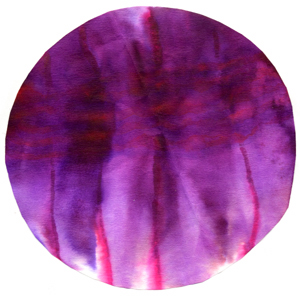
During one of our recent visits to The Tech Museum, we ran across a fun hands-on activity. The pretty purplish circle pictured here is what the younger Free-Ride offspring produced in this activity.
The kids thought they were just doing an art project. But there’s science in that art.
The art project works using the same principles as a time-honored separation technique called paper chromatography. In this post, I’ll lay out some ways you can play with paper chromatography at home, and I’ll point you toward the scientific principles at work underlying the behavior of the materials you’ll be playing with.
The big idea behind paper chromatography is that you’re taking a substance (like ink) and finding out whether it would rather stick to the “stationary layer” (the paper) or dissolve in, and travel with, the “mobile layer” (a solvent, such as water). What makes playing around with paper chromatography fun is that a good number of the inks in your household markers are actually mixtures of different substances, some of which are happier stuck to the paper, others of which are more at home dissolved in the water, and some of which are ambivalently in between.
What makes water a “mobile layer” here is the capillary action that helps it creep through the pores in a paper towel, a coffee filter, or really good filter paper. That capillary action is connected to the hydrogen bonding that helps water molecules “stick” to other molecules. If you dip just the end of a paper towel in a glass of water, you can observe the moisture climbing up the paper towel. That’s the water molecules pulling (via hydrogen bonding) more water molecules through the capillary-like spaces in the towel until the downward pull of gravity balances out the “come with me!” pull of the intermolecular attractions.

In paper chromatography, though, we’re not just letting water climb up the paper. Instead, a little way up from the bottom of the paper, we’ll dangle some potentially attractive goodies in the water’s path. (I mean “attractive” quite literally here — substances that dissolve in water are made of molecules that develop good intermolecular attractions with water molecules, whereas the substances that stay put on the paper are made of molecules that have stronger intermolecular attractions with the paper molecules than with the water molecules.)
I decided black ink from an array of different pens might present the water with some attractive goodies. I cut a piece out of a white coffee filter and put a spot of ink from each of the black pens across the bottom. Then I dipped the very bottom of the piece of coffee filter in a small bowl of water and let the water creep up until it seemed to stop creeping.
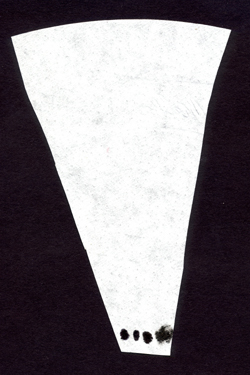

The top image here shows the strip of coffee filter before I dipped it in the water.
The image directly below it shows what it looked like after the water stopped its climb.
You’ll notice that two of the black spots seemed not to do much of anything. Those ink samples seem quite happy sticking to the paper, even when wet. (One of those spots, by the way, is ink from a dry erase pen.) Possibly if I had used a different solvent (like rubbing alcohol) as the mobile layer they might have clung less tenaciously to the paper, but I can’t say for sure because I didn’t do that experiment.
You will notice, however, that two of the initial ink spots were pulled upward by the climbing water. One of them spread into a nice black smudge with some purplish bits, while the spot on the far left seemed to spread into a whole array of colors. This suggests that black inks can be compounded from components of many colors, and that those different colored components have different affinities for the water and the paper.
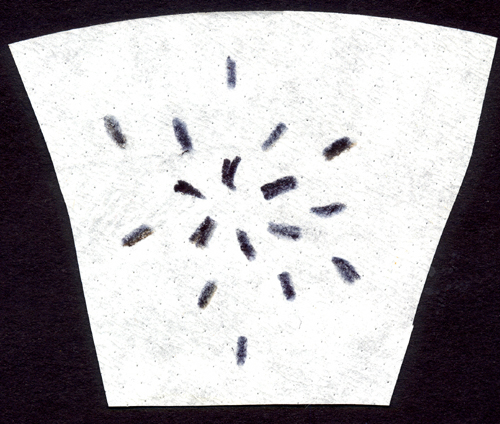
I wanted to play around a little with the ink from the far left, and I didn’t want to be beholden to gravity in terms of how much spread I could get through the paper. So I cut out another piece of coffee filter, put some little scribbles of the ink on it, and made myself a nice flat work surface. I used a plastic cutting board on a kitchen counter. I would recommend against using a carpet or an unfinished wood surface, since there’s a possibility that the ink components that go into solution in the water will be quite happy to stick to that carpet or unfinished wood surface; you really want the paper to be the stationary layer here!
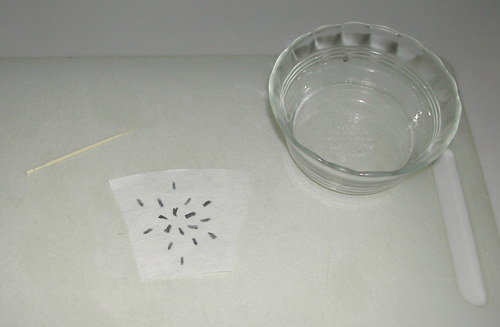
If you have a little eye dropper to drop the water in the ink, you can use that. I used a toothpick instead. The idea is to put the water on the ink rather than on the blank spots in the filter. That way, the ink components can go into solution and spread out horizontally into the blank areas. If you get the blank areas wet first, the water that’s dissolving the ink components won’t be able to spread into those blank areas — the capillary action is pulling the water into the parts of the paper that are still dry.
Keep dropping water on the ink until you’re satisfied with how far things have spread.
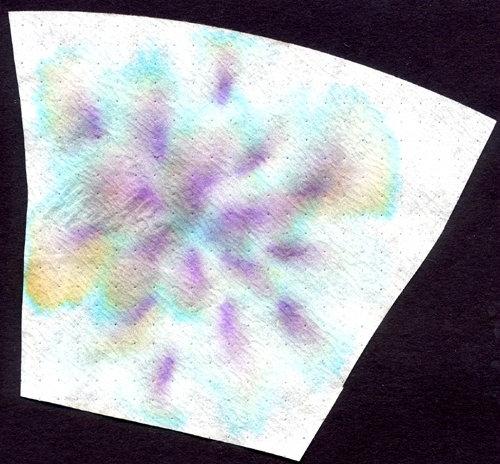
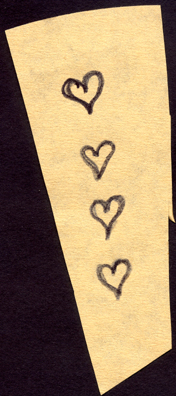
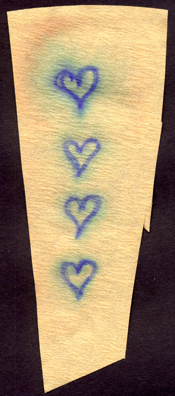
Part of the reason I used pieces of white coffee filters (and fairly small pieces at that) is that we don’t usually have white coffee filters in the house. We usually use the unbleached ones.
I thought, in the interests of science, I should try to determine whether those brown hippie coffee filters might also work to produce attractive paper chromatography art.
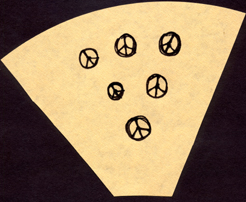
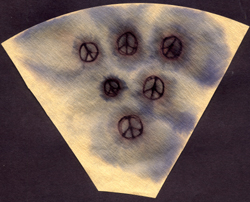
I used each of the two black pens with ink that spread nicely in water on the white filters.
The verdict? Meh.
It’s hard to be certain exactly why the results with the brown filters are so underwhelming. Possibly the subtle colors visible on the white filter are simply harder to pick out on the brown filters. But it’s also quite possible that the unbleached filter paper has different surface properties, and that as a result the various components in the black inks stick to the unbleached paper with a different affinity than they have for the white paper.
Luckily, the unbleached filters still brew good coffee.
It’s worth pointing out that not everyone drinks coffee (and that some coffee drinkers are loath to sacrifice a coffee filter to any activity that does not result in a pot of freshly brewed coffee).
Not to worry — you can achieve the same kind of effect using paper towels.
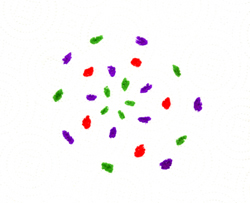
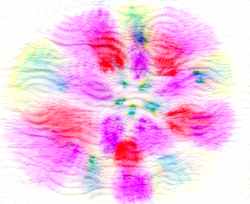
And, as you can see from the before and after pictures, you can start with colored inks as well. Again, the key to getting a nice spread is to drop the water directly on the parts of the paper towel where you’ve placed the ink. The spreading water will do the job of bringing color to those blank bits.

Thanks for this great post. It brought back some of my first memories of science. My dad was an analytical chemist.
In college and grad school, i used to use the little trimmed off leftovers of Whatman to draw with different color Sharpies, stick an edge into a shallow dish of water, let the dyes separate, then dry and use them as bookmarkers.
Paper chromatography also makes for fun detective games.
A sample of very rare ink was found at the scene of a crime. Police searched the offices of three suspects and found some ink in each. Using chromatography, you can see which ink matches the sample found at the scene of the crime. This can also lead onto a discussion of DNA fingerprinting, which is probably the most famous type of this sort of thing.
I use this with my year 7 science (ages 11-12) classes as part of a module on seperations chemistry. The whole module is turned into CSI Billingshurst and the kids seem to enjoy it.
Brown inks are almost always made up of multiple colors which spread at different rates.
Something I discovered with a brown flair pen and filter paper many years ago.
Thanks for this.
Is there anything I can use in place of filter paper that I would find around the house, e.g. toilet paper or paper kitchen towels, that would do the job? I’m planning to do a bit of science with my seven-year-old cousin when I go over to visit soon, and this looks good; I can safely assume that she will have plenty of magic markers to play with!
Can you also recommend a good, possibly practically-based and easily approachable, science book for a child of this age? I still owe her a birthday present, and I have a policy of buying her and her sister (who’s not quite three) gifts that will stretch their brains.
I didn’t know p-chemists got excited about paper chromotography like the rest of us o-chem nerds. Nice
what kind of markers or pens do we have to use ?????
or get???? this experiment